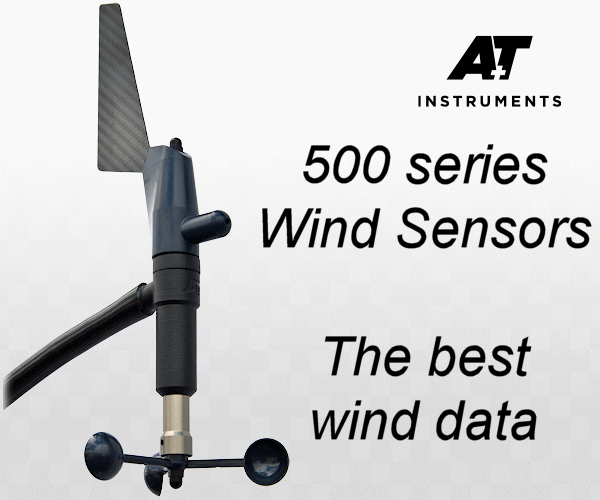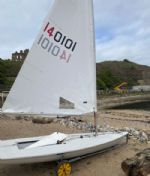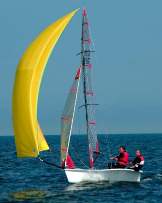



-(1)-202408140552.gif)








Boats for sale
| Rossiter Pintail Mortagne sur Gironde, near Bordeaux |
 |
| Laser 28 - Excellent example of this great design Hamble le rice |
 |
| Laser 140101 Tynemouth |
 |
List classes of boat for sale |
Raking Rigs |
Post Reply 
|
Page <1234> |
| Author | ||
mole 
Groupie 
Joined: 02 Feb 06 Location: United Kingdom Online Status: Offline Posts: 43 |
 Post Options Post Options
 Quote Quote  Reply Reply
 Topic: Raking Rigs Topic: Raking RigsPosted: 02 Nov 13 at 10:31pm |
|
|
It reduces the chord length so reducing the power,drag and heel.
Bit like reducing the richness of the carburetor, if anyone can remember what they were! There is no such thing as dynamic lift. Remember, dinghy rigs are all about reducing drag. The power generated is roughly all the same. Hence why new sails seem so efficient, they have less drag (stretch) We are running at numbers far below normal aerodynamic speeds compared to aircraft including gliders. One bad tack can eliminate all the gains from a slight gain in rig set up. Go and practice :)
|
||
 |
||
andymck 
Far too distracted from work 
Joined: 15 Dec 06 Location: Stamford Online Status: Offline Posts: 397 |
 Post Options Post Options
 Quote Quote  Reply Reply
 Posted: 03 Nov 13 at 12:39am Posted: 03 Nov 13 at 12:39am |
|
|
Let's think about the things that move the centre of effort forward in a sail as we get overpowered.
1. Cunningham. The Cunningham is designed to flatten and pull the centre of effort forward. Increased by blading off if the trailing edge higher up. 2. Mast bend. This again drags the chord and therefore centre of effort forward. 3. Easing the sails. Again this brings the centre of effort forward. I am sure the canoe and several of the other boats Jim sails have the ability to adjust the rake to reset the centre of effort. Like I said, it is complicated. But a fast boat up wind is balanced. You have to re balance the boat with each major adjustment. This can also be done in various different ways. I have already alluded to one way in a two sailed boat which is to depower the jib by increasing twist or easing it. I Have also suggested its a trial and error issue for each variation of boat and rig, but actually we are achieving similar results by doing different things. To answer Rupert's question about rake and mast bend. This is a dynamic between rig tension and spreader angle, the amount of forward pressure by the vang or main sheet arrangement, the luff tension, and the low down mast support. As the mast gate is often fixed, or the lowers are often non adjustable, as the mast is raked the vang puts more relative forward motion on the lower mast. Merlin's for example have their lowers involved in the one string taking system to reduce this. Some classes such as the phantom can adjust lowers to get same effect. This makes a huge difference to the mast tip position. On a N12 mast you can get the mast tip to move a good 6 inches by playing with the lower mast supports, hence tuning numbers for initial rake set up are normally given with lowers and mast ram in an unloaded position. By manipulating these you can change where the bend occurs in the mast. For instance more lower tension and a lot of Cunningham encourages higher up bend and tip response. Release both and you get a very unresponsive flat sail with a tight leech. This can be good for pointing. Bottom line is you have to experiment. But that is half the fun. |
||
|
Andy Mck
|
||
 |
||
Mike Holt 
Groupie 
Joined: 29 Nov 09 Location: United States Online Status: Offline Posts: 58 |
 Post Options Post Options
 Quote Quote  Reply Reply
 Posted: 03 Nov 13 at 1:15am Posted: 03 Nov 13 at 1:15am |
|
We have a flattener that moves the boom back up about 10" when the boat is all the way "upright" the boom is easy to get under, all the way back and the flattener it is starting to be a challenge! In extreme conditions I will ease the kicker to tack. I think carbon would improve the gust response and weight aloft but would probably take a year or two to get optimized on the sail cut, same for changing to a square top. As for the "one bad tack" a well set up boat will allow you to make a lot of bad tacks in my experience and the winners have good boat speed and don't tack too badly!
|
||
 |
||
Do Different 
Really should get out more 
Joined: 26 Jan 12 Location: North Online Status: Offline Posts: 1312 |
 Post Options Post Options
 Quote Quote  Reply Reply
 Posted: 03 Nov 13 at 8:40am Posted: 03 Nov 13 at 8:40am |
|
|
||
 |
||
RS400atC 
Really should get out more 
Joined: 04 Dec 08 Online Status: Offline Posts: 3011 |
 Post Options Post Options
 Quote Quote  Reply Reply
 Posted: 03 Nov 13 at 9:54am Posted: 03 Nov 13 at 9:54am |
|
Does it? Not sure that's true in a Merlin. |
||
 |
||
Dark Harris 
Newbie 
Joined: 16 Jul 13 Location: Gloucestershire Online Status: Offline Posts: 18 |
 Post Options Post Options
 Quote Quote  Reply Reply
 Posted: 03 Nov 13 at 11:02am Posted: 03 Nov 13 at 11:02am |
|
|
Sorry Oats but when on the water we are not half way up the beat removing clevis pins and adjusting the shrouds! The single handers are just easing the rig back by releasing forestay tension. Rig tension goes to nothing, then pull the kicker on till your ears pop. Generally, unless it's blowing dogs off chains this will be just up the beat or a tight fetch and then, downwind you would ease the kicker and slap some rig tension back on to bring it upright again. So mast bend doesn't come into it.
|
||
|
When they say you are too old you probably are, but do it anyway.
|
||
 |
||
Oatsandbeans 
Far too distracted from work 
Joined: 19 Sep 05 Location: United Kingdom Online Status: Offline Posts: 382 |
 Post Options Post Options
 Quote Quote  Reply Reply
 Posted: 03 Nov 13 at 5:31pm Posted: 03 Nov 13 at 5:31pm |
|
|
D H -yes I don't adjust rake on the water, its not impossible but I like to concentrate on other things once I have left the beach. If you have a decent set of double row shroud adjusters and a good weather forecast you should be able to sort it out pretty close before you launch. Lots of sailors don't adjust the rake because its a hassle and they cant be bothered, and opt for an average rake position, and use the secondary controls (vang and cunn) to adjust the power.I have 4 shroud positions and most of the time I get it quite close to be optimal. I think it makes a big difference to how the boat goes (speed, pointing, power and feel) when the rake is right for the wind strength, and its no more hassle than picking the right gear to wear.
|
||
 |
||
craiggo 
Really should get out more 

Joined: 01 Apr 04 Location: United Kingdom Online Status: Offline Posts: 1810 |
 Post Options Post Options
 Quote Quote  Reply Reply
 Posted: 03 Nov 13 at 5:43pm Posted: 03 Nov 13 at 5:43pm |
|
I'm with you 400atC. It amazes me how little people know, but how much they are willing to spout as if they knew it. Raking the rig increases chord, fact. As to the effect this has, well it really depends on how the mast is supported and how you trim the sail out. Most classes will rake the rig on the shore by dropping the shrouds down a hole or two, and then applying normal rig tension. Lowers will need to be adjusted but differently on various classes due to geometry. Merlins have shrouds, forestay, lowers and kicker all connected, but most of us have to adjust all this stuff independently. It can be done on the water, but most will need to adjust for the day! |
||
 |
||
Slippery Jim 
Really should get out more 

Joined: 24 Nov 09 Location: Germany Online Status: Offline Posts: 586 |
 Post Options Post Options
 Quote Quote  Reply Reply
 Posted: 03 Nov 13 at 9:08pm Posted: 03 Nov 13 at 9:08pm |
|
|
Keep it simple, why not have a automatic rig AKA 49er, 29er 59er... once set up, sail and smile... You spend more time looking out of the boat than pulling on bits of string.
|
||
|
Pass the skiff, man!
|
||
 |
||
boatshed 
Far too distracted from work 
Joined: 12 Apr 05 Online Status: Offline Posts: 457 |
 Post Options Post Options
 Quote Quote  Reply Reply
 Posted: 04 Nov 13 at 11:45am Posted: 04 Nov 13 at 11:45am |
|
|
Umm, seems like lots of twaddle being spouted.
What is clear is that moving the mast back a bit doesn't materially increase the chord. Neither does it decrease weather helm or give vertical lift because the rig needs to be canted to windward fore this, windsurfer style. It seems the only boats that practice rig raking are medium to high performance boats with swiveling centre boards. As these boats begin to plane upwind, they need much less area of their boards in the water and the only way to reduce board area is to rake it back. To re balance the boat, the mast is raked back plus the cunningham is applied to the main sail. Now the drive is much lower down and the C of E further back. I'm not sure but when the cunningham is applied hard and the the top of the main is twisted off , does the C of E move backwards in the remaining, driving part of the rig ? So, 5o5s, Contenders, Fireballs etc all benefit. But low performance boats probably don't benefit as they never go quick enough upwind to start tripping over their board. There is a secondary benefit of raking a mast as it opens loosens the jib leach making it twist but that can be achieved other ways without raking. Tack height, jib cars etc Boats with dagger boards are much simpler. They just lift the board to reduce area and the Cof E just moves up and not backwards. Therefore, the mast doesn't need raking, just the cunningham applying to to twist the main to lower it's C o E. The jib is twisted off by lowering the tack. One of the great advantages of dagger board boats is the ability to change gear so easily. As the breeze builds, pull the dagger board up, pull the cunningham hard on and crack the jib off. Job done. Edited by boatshed - 04 Nov 13 at 11:46am |
||
|
Steve
|
||
 |
||
Post Reply 
|
Page <1234> |
| Forum Jump | Forum Permissions  You cannot post new topics in this forum You cannot reply to topics in this forum You cannot delete your posts in this forum You cannot edit your posts in this forum You cannot create polls in this forum You cannot vote in polls in this forum |
Bulletin Board Software by Web Wiz Forums® version 9.665y
Copyright ©2001-2010 Web Wiz
Change your personal settings, or read our privacy policy
Copyright ©2001-2010 Web Wiz
Change your personal settings, or read our privacy policy











 Printable Version
Printable Version Delicious
Delicious Digg
Digg Facebook
Facebook Furl
Furl Google
Google MySpace
MySpace Newsvine
Newsvine reddit
reddit StumbleUpon
StumbleUpon Twitter
Twitter Windows Live
Windows Live Yahoo Bookmarks
Yahoo Bookmarks Topic Options
Topic Options